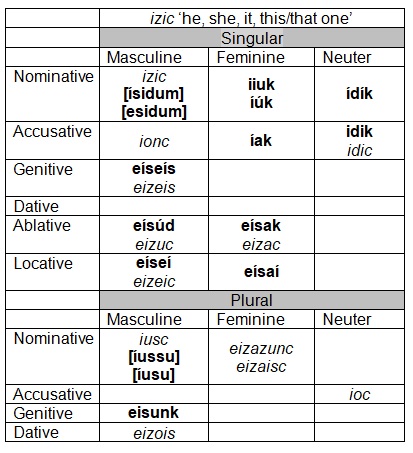Pronouns
Salavs! You’ve mastered verbs – in this lesson, we’re going to look at pronouns. We’ll also continue to use lots of the vocabulary from the previous lessons, so keep using those flashcards.
Pronouns are words which stand in the place of nouns. For example, I could say “Katherine writes a blog. She updates it almost every day.” Here, ‘she’ is a pronoun, standing in for ‘Katherine’.
In Oscan, as in lots of ancient languages, we don’t need these kinds of pronouns that often – it is more normal to use just the verb, since the verb ending tells you most of the information you need anyway. But sometimes Oscan does use pronouns – usually when the context is ambiguous, or the writer wants to add emphasis.
Personal and possessive pronouns
There are not many of these attested. Here are the ones we have.
Personal
- íív – I (nominative singular) (at least, probably! only attested once)
- tiium, tiu – you (nominative singular)
- tfei – for you (dative singular)
- sífeí – for himself/herself/itself (dative singular)
- siom – himself/herself/itself (accusative singular)
Possessive
- tuvai – your (describing a feminine dative singular noun)
- suveís – his/her/its (describing a masculine or neuter genitive singular noun)
- suvam – his/her/its (describing a feminine accusative singular noun)
- súvad – his/her/its (describing a feminine ablative singular noun)
Relative, interrogative and indefinite pronouns
Relative pronouns (who, which) are used to introduce a clause describing a noun – for example, ‘The cat, who is blue, is from the moon,’ or ‘The cat, whose owner is neglectful, has been dyed blue.’ Interrogative pronouns have very similar forms (in English, Latin and Oscan), and are used to ask questions, like ‘Whose blue cat is that?’ or ‘Which cat are you thinking of adopting?’ There are also indefinite pronouns, which stand in for a noun of uncertain identity – ‘Whoever dyed this cat blue is in big trouble.’
In Oscan, there was broadly a division between the relative pronouns on the one hand, and the interrogative and indefinite pronouns on the other. The indefinite pronouns are particularly common in legal texts, which often specify that whoever acts in a certain way will be subject to a particular punishment. There are not quite enough attestations to be completely sure that the forms were always used as in the table below – this is a best guess. (See Buck for more information.)

You might notice that these are very similar to the Latin relative and interrogative pronouns qui/quis/quae/quod, but starting with p- instead of q-. In fact, all these terms go back to the same Proto-Italic root. But Oscan is more fun to say.
Exercise
You are now ready to read the cutest Oscan inscription in existence. It’s hard to see the whole text from the photograph – try writing it out in the Oscan alphabet. Then translate. Hint: kúrú means ‘stone’ (feminine nominative singular).

pis : tiú :
íív : kúrú :
púiiu : baíteís :
aadiieís : ahfineís :
Highlight to reveal translation:
Who (are) you?
I (am) a stone.
Whose?
Baitis Aadiis Afinis’s.
You can read my blogpost on this inscription over here.
Demonstratives
It’s much more common to find a pronoun in Oscan when the writer needs to emphasise something – for example, to specify ‘this one’ or ‘that one’. The combination of lots of attested forms and inconsistent spellings makes these very tricky to learn – so don’t worry too much. As long you can recognise which pronoun you are looking at, you can look up the form in the table.
It’s also very common to see the pronoun izik with the suffix -dum, in which case it means ‘the same’. The most frequent form is ísídum or esídum ‘the same (masculine singular nominative)’ and therefore usually ‘the same man’, and the plural íussu ‘the same men’. These forms are in brackets in the table.

We already met ekík in the phrase ekík . pavmentúm in Lesson 4. Here’s the rest of the paradigm for ‘this’.

Exercises
(1) Transcribe and translate this inscription from the Nolan gate in Pompeii, around the second century BCE. (Hint: med. túv. is an abbreviation for meddiss túvtiks – ‘public magistrate’. This was the chief meddix in many Oscan-speaking cities.)

Highlight below for transcription and translation:
V . Púpidiis . V / med . túv / aamanaffed / ísídu(m) / prúfatted
Vibis Púpidiis son of Vibis / public meddix / ordered (this gate) / (and) the same man / approved (it).

(2) Transcribe and translate this inscription, also from Pompeii. (Hint: med. túv. is an abbreviation for meddiss túvtiks – ‘public magistrate’. passtata means something like ‘portico’.)
Highlight below for transcription and translation:
V . Púpidiis . V / med . túv / passtata . ekak / úpsan(nam) / deded . ísídu(m) . prúfatt(e)d
Vibis Púpidiis, son of Vibis, public meddix, gave the building of this portico, (and) the same man approved (it).

(3) Translate this sentence of the Tabula Bantina, a legal inscription written in Bantia around 90 BCE. (Extra vocab: ampert ‘provided that’, mistreis ‘smaller’ (genitive singular), aeteis ‘part’ (genitive singular)
inim suae pis ionc meddis moltaum herest, licitud, ampert minstreis aeteis eituas moltas, moltaum licitud.
Highlight below for translation:
And if any meddix wants to fine him, it is allowed, provided that the fine is of the smaller part of his money [i.e. as long as it is less than half his property].
More practice: some flashcards for the vocabulary from today.
Congratulations! You’ve finished all the basic Oscan grammar lessons. The next lessons will be inscription spotlights, so you can read some more real inscriptions and built your vocabulary.

